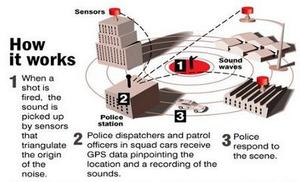Use of crime-fighting ShotSpotter technology to be expanded in Nassau County
For a year now Nassau County, New York, police department has been using the ShotSpotter system, and the country police commissioner says the department has been able to handle shootings much more swiftly, and that in certain instances lives might have been lost if it were not for the technology; the system records the number of shots fired, whether the shooter was stationary or moving, and provides audio playback of each gunshot event; this information not only provides situational awareness for law enforcement officers prior to arriving at the crime scene, but it is also offers valuable evidence for post crime analysis and legal proceedings

ShotSpotter has proven effective // Source: wordpress.com
For a year now the police in Mineola, Long Island, has been able to respond within seconds in cases of shooting. The date of 23 August 2009 marked the one-year anniversary of the first arrest made by the Nassau County Police Department which was based on the ShotSpotter System at. The system is currently in full operation in Roosevelt and Uniondale. County Police Commissioner Lawrence Mulvey said the department is looking to expand the system’s use to other communities in Nassau County.
Rich Forestano writes in the Mineola American that the department said it would most likely expand the system to Lakeview, but that it is not yet clear what other communities are being considered for the ShotSpotter System.
Initially, ShotSpotter terminals were only located in the Communications Bureau and officers were notified by dispatchers of gunfire and given the location. Since 7 May, however, patrol officers have been receiving notifications of shots fired in their patrol vehicles with specific locations and details at the same time as the NCPD Communications Bureau, which saves time.
The system accurately detects, pinpoints, and alerts police responders to the locations of gunfire and other explosive events. In other cities where the system has been deployed, the information provided by the ShotSpotter GLS has been credited with reducing gunfire rates by nearly 60 to 80 percent and violent crime by up to 40 percent (see “ShotSpotter, Inc. says its technology saves lives,” 9 September 2009 HSNW).
According to Commissioner Mulvey, ShotSpotter system sensors are calibrated to listen for the unique acoustic fingerprint of gunfire. When gunfire events occur, sensors triangulate and locate the gunshot’s point of origin to within 25 meters (82ft.).
The system records the number of shots fired, whether the shooter was stationary or moving, and provides essential audio playback of each gunshot event. This information provides situational awareness for law enforcement officers prior to arriving at the crime scene and invaluable evidence for post crime analysis.
Forestano notes that there are no cameras in the police vehicles, but Mulvey stated that it is “a phase we’re considering.”
The ShotSpotter system can also detect whether the shot was fired while, for example, a car was moving. It can determine which direction the car was heading, helping police narrow down which areas to patrol. The system can also detect the speed of a vehicle.
“Additionally, we know the nearest street address and whether the gunshot came from the front or side of a building,” Mulvey said. “Tactically, this is significant as it helps our officers respond faster and gives them a specific area to search for potential evidence, question witnesses, and in the event a victim is found, ensure that medical attention is timely. Most importantly, this system improves both the safety of the community at large and of our responding officers.”
Mulvey said in his examination of the year of ShotSpotter, that the department has been able to handle shootings much more swiftly and in certain instances, lives might have been lost if it were not for the technology. “We had one instance where a man was shot at point blank range at a house party,” Mulvey stated at police headquarters. “ShotSpotter picked it up, logged it and told police where the shot was fired and authorities responded within minutes of it occurring and took the necessary steps to get the man to the hospital. Doctors said had he arrived at the hospital a few minutes later, he may not have survived.”
Mulvey stated further that ShotSpotter is not designed to make arrests, but that it is designed to deter shootings and violent crime. He believes it is working. “Offenders know about this system,” he said. “They’re wary of it and if it keeps one less gun from firing, then it’s working. If it keeps one less person from being hurt or killed, it’s working.”
